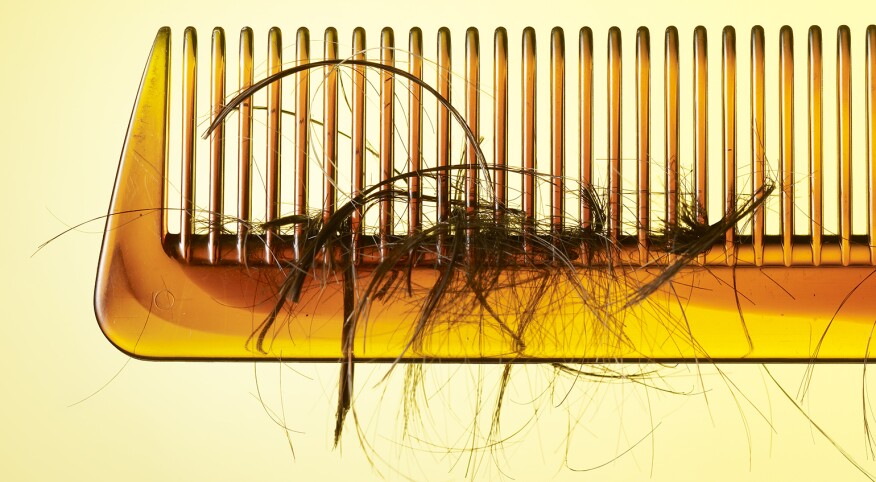Jodi Gomes* straightened her curly hair every morning for 20 years, using a brush, blow-dryer and flat iron. When the 38-year-old recently began noticing more hair than usual on the shower floor, she booked an appointment with a dermatologist, who asked Gomes about her hairstyling practices … as well as her overall health and stress levels.
“I’d gone through a rough patch with work a few months earlier,” she says, “plus we were in the process of moving.” The doctor deemed stress, combined with aggressive styling, the likely culprits. “I knew that excess stress and heat weren’t good for your hair, but I never realized they could make it start falling out in clumps! My hair ties weren’t even staying in. My ponytail was like a baby’s.”
Think hair loss is the domain of husbands and fathers only? Women actually make up close to half of American
hair loss cases. Dr. Amy McMichael, chair of dermatology at the Wake Forest Baptist Medical Center, says it's normal to lose between 50 and 100 strands of hair a day, depending on what genetic cards you've been dealt. But a number of possible factors, including aging, changing hormone levels, medication side effects and more can conspire to push that number up. McMichael says you can try this classic test: Grab about 40 strands of hair at the root and, applying gentle yet firm pressure, move your hand down to the ends. Ideally, a maximum of zero to two will come out. More than that? It may be time to see a dermatologist.
Here's what the doctor may tell you:
You’re over-stressed. Hair follicles are programmed to continuously cycle through a growth phase and rest phase, the growth phase lasting two to seven years, the rest phase (also called the telogen phase) about three months, after which they shed. On any given day, the majority of hairs on your head are in growth phase.
But when you shock your system — with serious stress, a surgery, a new medication, a divorce, a job loss — the body sometimes sends a signal to the hair follicles to shift from growth to resting. The exact reason isn’t known, but McMichael says it may be an evolutionary adaptation; a body under stress wants to conserve energy to survive, so it shuts down non-essential functions, like hair growth.
The resulting sudden hair loss is called
telogen
effluvium (TE). Clogged shower drains typically aren’t noticed for a few weeks to a few months post-shock; it takes a while for the hair to actually fall out. Thankfully, TE tends to reverse itself once the stress is resolved.
You just gave birth. Estrogen levels nosedive after delivery, leading to hair loss about three months thereafter. Hair typically begins filling back in by a year post-partum.
You’re getting older. Age is the most common reason behind hair loss, impacting about 80 million women and men in the U.S., according to the American Academy of Dermatology. In women, this type of hair loss, known as female pattern baldness, usually starts gradually, often in perimenopause, a result of declining estrogen levels and increasing testosterone levels, first manifesting as a widening part and gradual thinning of hair at the crown of the head.
You're over-styling your hair. Hitting the flat-iron too hard or pulling your ponytail back too tightly can lead to hair breakage. Aishia Strickland, cofounder of Black Girl Curls, notes that this type of hair loss is a frequent concern among African-American women, especially those with braided styles and sew-ins, which place excess tension on the scalp.
Other hair saboteurs. Thyroid disease, anemia or other underlying health issues; poor diet; or
alopecia areata
, a disease in which the immune system attacks hair follicles, resulting in a total loss of hair.
Now what?
After addressing any underlying medical problems, hair may begin growing back. If the issue is ongoing, genetic or age-related, Minoxidil, the active ingredient in Rogaine, may help. Dr. Carolyn Goh assistant clinical professor of dermatology and director of the Clinic for Hair and Scalp Disorders at the University of California, Los Angeles, says women can use a 2 percent solution twice daily or 5 percent foam once daily. In many cases, this will halt hair loss, and possibly help spur regrowth. You’ll need to use it indefinitely, though. (The risks of topical Minoxidil during breastfeeding aren’t known, Goh says.)
Also, ask your stylist about camouflaging hair loss with a strategic hair cut and color combination, advises Gabrielle Buttitta, senior stylist with Bentley Hair & Beauty in Chicago. Shorter cuts tend to appear fuller, “and color adds dimension, giving the illusion of thickness and depth.”
Self-conscious about your scalp peeking through? Buttitta recommends
Color Wow Root Cover Up. Choose a color that matches your hair to reduce contrast between your scalp and strands. “The eye shadow constancy means it’s more easily controlled than sprays,” she says. Or try
TOPPIK Hair Building Fibers, which are shaken into your hair and cling to hair follicles to prevent scalp peek-a-boo.
*Name has been changed.

Sam Kaplan / Trunk Archive









